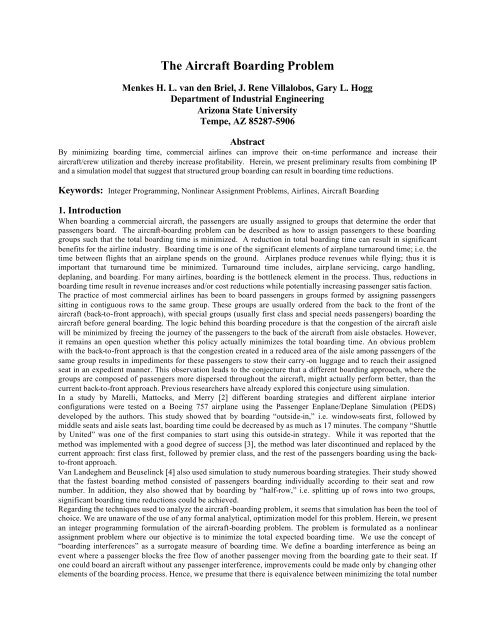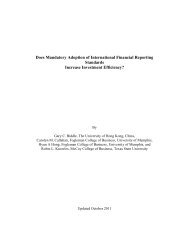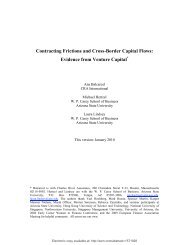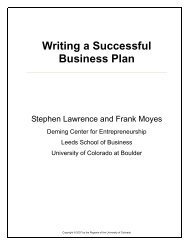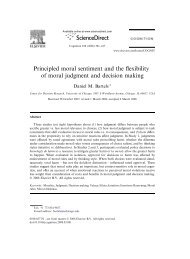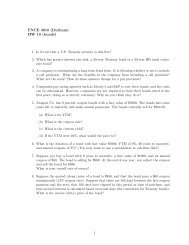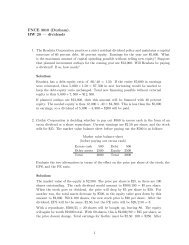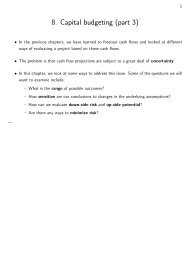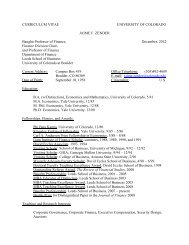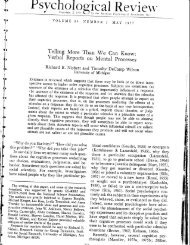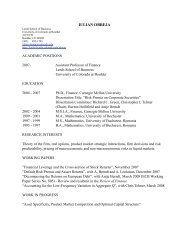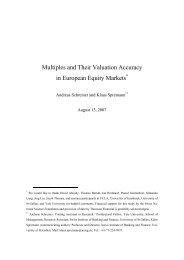The Aircraft Boarding Problem - Menkes van den Briel
The Aircraft Boarding Problem - Menkes van den Briel
The Aircraft Boarding Problem - Menkes van den Briel
Create successful ePaper yourself
Turn your PDF publications into a flip-book with our unique Google optimized e-Paper software.
<strong>The</strong> <strong>Aircraft</strong> <strong>Boarding</strong> <strong>Problem</strong><strong>Menkes</strong> H. L. <strong>van</strong> <strong>den</strong> <strong>Briel</strong>, J. Rene Villalobos, Gary L. HoggDepartment of Industrial EngineeringArizona State UniversityTempe, AZ 85287-5906AbstractBy minimizing boarding time, commercial airlines can improve their on-time performance and increase theiraircraft/crew utilization and thereby increase profitability. Herein, we present preliminary results from combining IPand a simulation model that suggest that structured group boarding can result in boarding time reductions.Keywords: Integer Programming, Nonlinear Assignment <strong>Problem</strong>s, Airlines, <strong>Aircraft</strong> <strong>Boarding</strong>1. IntroductionWhen boarding a commercial aircraft, the passengers are usually assigned to groups that determine the order thatpassengers board. <strong>The</strong> aircraft-boarding problem can be described as how to assign passengers to these boardinggroups such that the total boarding time is minimized. A reduction in total boarding time can result in significantbenefits for the airline industry. <strong>Boarding</strong> time is one of the significant elements of airplane turnaround time; i.e. thetime between flights that an airplane spends on the ground. Airplanes produce revenues while flying; thus it isimportant that turnaround time be minimized. Turnaround time includes, airplane servicing, cargo handling,deplaning, and boarding. For many airlines, boarding is the bottleneck element in the process. Thus, reductions inboarding time result in revenue increases and/or cost reductions while potentially increasing passenger satis faction.<strong>The</strong> practice of most commercial airlines has been to board passengers in groups formed by assigning passengerssitting in contiguous rows to the same group. <strong>The</strong>se groups are usually ordered from the back to the front of theaircraft (back-to-front approach), with special groups (usually first class and special needs passengers) boarding theaircraft before general boarding. <strong>The</strong> logic behind this boarding procedure is that the congestion of the aircraft aislewill be minimized by freeing the journey of the passengers to the back of the aircraft from aisle obstacles. However,it remains an open question whether this policy actually minimizes the total boarding time. An obvious problemwith the back-to-front approach is that the congestion created in a reduced area of the aisle among passengers of thesame group results in impediments for these passengers to stow their carry -on luggage and to reach their assignedseat in an expedient manner. This observation leads to the conjecture that a different boarding approach, where thegroups are composed of passengers more dispersed throughout the aircraft, might actually perform better, than thecurrent back-to-front approach. Previous researchers have already explored this conjecture using simulation.In a study by Marelli, Mattocks, and Merry [2] different boarding strategies and different airplane interiorconfigurations were tested on a Boeing 757 airplane using the Passenger Enplane/Deplane Simulation (PEDS)developed by the authors. This study showed that by boarding “outside-in,” i.e. window-seats first, followed bymiddle seats and aisle seats last, boarding time could be decreased by as much as 17 minutes. <strong>The</strong> company “Shuttleby United” was one of the first companies to start using this outside-in strategy. While it was reported that themethod was implemented with a good degree of success [3], the method was later discontinued and replaced by thecurrent approach: first class first, followed by premier class, and the rest of the passengers boarding using the backto-frontapproach.Van Landeghem and Beuselinck [4] also used simulation to study numerous boarding strategies. <strong>The</strong>ir study showedthat the fastest boarding method consisted of passengers boarding individually according to their seat and rownumber. In addition, they also showed that by boarding by “half-row,” i.e. splitting up of rows into two groups,significant boarding time reductions could be achieved.Regarding the techniques used to analyze the aircraft -boarding problem, it seems that simulation has been the tool ofchoice. We are unaware of the use of any formal analytical, optimization model for this problem. Herein, we presentan integer programming formulation of the aircraft-boarding problem. <strong>The</strong> problem is formulated as a nonlinearassignment problem where our objective is to minimize the total expected boarding time. We use the concept of“boarding interferences” as a surrogate measure of boarding time. We define a boarding interference as being anevent where a passenger blocks the free flow of another passenger moving from the boarding gate to their seat. Ifone could board an aircraft without any passenger interference, improvements could be made only by changing otherelements of the boarding process. Hence, we presume that there is equivalence between minimizing the total number
of interferences and the total boarding time. In this paper, we present the development of the analytical model first,and then we build a simulation model of the aircraft-boarding procedure for an Airbus 320 (A320) airplane. Wethen perform a cross-validation between the analytical and simulation models. Finally, we use the simulation modelto explore different aircraft-boarding scenarios.2. Interference model<strong>The</strong> minimization of total boarding time by assigning passengers to boarding groups is the goal of the aircraftboardingproblem. However, explicitly including time related parameters in an analytical model increases thecomplexity of the model representation and solution. Thus we resorted to a surrogate metric for time, the number ofexpected passenger interferences under a particular assignment strategy. We model the aircraft-boarding problem asa binary integer program with minimization of the total number of interferences as its objective function. We callthis model the “interference model.” We make the assumption, without a formal argument, that the minimization ofinterferences is equivalent to the minimization of total boarding time. In the interference model, we seek a groupingof passengers that will minimize the total number of expected interferences. An assumption of the model is thatevery passenger has been pre-assigned to a particular seat of the aircraft. A detailed discussion of interferences andthe model development follows.2.1 Types of interferenceWe define two types of interferences, seat interference and aisle interference. Seat interference occurs when awindow or middle seat passenger boards later than the middle and/or aisle seat passenger that sits on the same sideand same row of the aircraft. For example, assume a passenger is seated in seat 7C (aisle seat in row 7). When thepassenger with seat 7B (middle seat in 7) boards the aircraft, passenger 7C must get out of their seat to allowpassenger 7B access. <strong>The</strong>re may be an even longer delay when passenger 7A (window seat in row 7) arrives andpassengers 7B and 7C are already seated. Note that putting window-seat passengers in the groups boarding firstwould minimize this type of interference.By aisle interference, we mean the situation when a passenger boarding the aircraft has to wait for the passenger infront of them to take their seat and to stow their luggage before proceeding to their seat, located further back in theaircraft. Aisle interferences involve two passengers; we refer to the “first” passenger as the passenger right ahead ofthe “second” passenger although they do not necessarily have to board as the first and second passengers in theboarding process. Aisle interference can occur within one group, or between two consecutive groups. Note that weassume passengers do not try to pass other passengers in the aisle of the aircraft.2.2 Formulation of the aircraft-boarding problemConsider an airplane having only one aisle with three seats on each side of the aisle (typical of Airbus 319 and 320,and the Boeing 737 and 757). Let N = {1, 2, 3, …, n} represent the set of rows and M = {A, B, C, D, E, F} representthe set of seat positions in the aircraft. In addition, let the seats on the left side of the aisle be represented by L = {A,B, C} and those on the right side by R = {D, E, F}, thus A and F are window seats, B and E are middle seats, and Cand D are aisle seats. Given a row number i ∈ N and a seat position j ∈ M, all seat locations in the aircraft can beuniquely i<strong>den</strong>tified and represented by the pair (i, j) just as in a normal aircraft, such as in seat (7, C).By assigning seats to groups (with a fixed seat assignment, this is similar to assigning passengers to groups) we areable to form groups of different sizes and composition. For the defined boarding problem, we want to assign eachseat (i, j) to a boarding group k, with k ∈ G, with G = {1, 2, 3, …, g}, where g is the total number of groups used inboarding the aircraft. Let the decision variable x ijk = 1 if seat (i, j) is assigned to group k and x ijk = 0 otherwise, for alli ∈ N, j ∈ M, k ∈ G.<strong>The</strong> complete formulation of the aircraft -boarding problem is presented below. In this formulation, the equationnumbers alongside the model serve to clarify the purpose of each set of expressions. In the objective function, wehave different penalties for each type of interference. Seat interferences have penalties represented by λ s and aisleinterferences by λ a . <strong>The</strong> penalties associated with the different types of interferences, capture their relativecontribution to the total delay of the boarding procedure. <strong>The</strong>se penalties are explained in detail in the next section.Minimize:ssλ ∑ ∑ xiAkxiBkxiCk+1 ∑ ∑z =1i∈Nk∈Gλ x x x + (1a)i∈Nk∈Gsssλ ∑ ∑ x x x + λ2iAk iBk iCl ∑ ∑ x x x +3iAk iBl iCk 4∑ ∑i∈ N k , l∈G:k < li∈ N k,l∈G:k < liFkiEkiDkλ x x x + (1b)iAli∈ N k , l∈G:k < liBkiCk
sssλ ∑ ∑ x x x + λ2iFk iEk iDl ∑ ∑ x x x +3iFk iEl iDk 4∑ ∑i∈ N k , l∈G:k < li∈ N k,l∈G:k
2.3 Determination of penaltiesValues for the penalties can be determined using a variety of procedures; e.g., using historical data one couldestimate the contributions of each type of interference to the total delay. <strong>The</strong> procedure that is followed in this paperis based on probabilistic expectations. <strong>The</strong> main assumption in the determination of these expectations is that theboarding position of a particular passenger within the group is equally likely. That is, a particular passenger within agroup can take any of different boarding positions within that group, with the same probability. Based on theseassumptions, the expected number of interferences will be computed and used as the penalty represented in theobjective function of the model by the λ’s.As an example consider the following: Suppose that three passengers on the same side of a row are assigned to thesame boarding group, passengers sitting in positions A (window), B (middle), and C (aisle). For purposes ofcomputing the seat interferences penalty, there are six different ways for these passengers to board the plane (ABC,ACB, BAC, BCA, CAB, CBA). Based on our assumptions, each of these boarding patterns is equally likely; however,the interferences caused by each differ. For example, the boarding pattern ABC implies that the window passenger(A) will board the plane first, passenger sitting in the middle seat (B) boards next (not necessarily immediately), andfinally the passenger sitting in the aisle seat (C). This represents the best-case scenario (zero penalty) because nopassenger would have to get up once seated. Now consider the boarding pattern ACB where the window seatpassenger boards before the aisle seat, who boards before the middle seat. In this case, there is one interference, theaisle seat passenger getting up for the middle seat passenger. Since each one of the boarding patterns is equallylikely (1/6 probability), once we determine the interferences associated with each one of the patterns it isstraightforward to obtain the expected value. <strong>The</strong> same procedure is used when the different passengers of the samerow and aisle side are assigned to different groups. For instance, suppose that the window and aisle passengers areassigned to the same boarding group. We will have one interference if the aisle passenger boards before the windowpassenger and none if the window seat passenger boards first. Since the probability of each of the two boardingpatterns is 0.5 and since we know that the middle passenger will be assigned to a different group causing aninterference of one with probability of one, the total expected interferences, and the penalty, for this case is 1.5.In Table 1, all expected interferences greater than zero with the corresponding penalty λ s are shown. <strong>The</strong> squaredbrackets ‘[ ]’ imply passengers boarding in the same group and the arrow shows the order of the boarding when thepassengers board in different groups. <strong>The</strong> order of the passengers within the boarding groups is assumed to berandom.Table 1. Expected seat interferencePenalty Passenger order E(#Interferences)λ [window, middle, aisle] 1.5s1λ [window, middle] → [aisle] 0.5s2λ [window, aisle] → [middle] 1.5s3sλ4[middle, aisle] → [window] 2.5λ [window] → [middle, aisle] 0.5s5λ [middle] → [window, aisle] 1.5s6sλ7[aisle] → [window, middle] 2.5λ [window] → [aisle] → [middle] 1s8λ [middle] → [window] → [aisle] 1s9sλ10[middle] → [aisle] → [window] 2λ [aisle] → [window] → [middle] 2s11λ [aisle] → [middle] → [window] 3s12In a similar way, we can calculate the expected aisle interferences. For aisle interferences within a boarding group,we are looking for the number of ways that two passengers can interfere with each other. Consider a boarding groupof size s 1 . One type of aisle interference is when the “second” passenger (the passenger boarding last) has a higherrow number (further back the plane) than the “first” passenger. If we assume the size of their boarding group to beequal to s 1 , then there are (s 1 – 1)( s 1 – 2)! out of s 1 ! ways the passengers could have boarded the airplane such that
the “first” and “second” passenger interfere with each other. <strong>The</strong>re are (s 1 – 1) positions for the two passengers toboard after one another leaving (s 1 – 2)! ways for the other passengers to board in a group of size s. With s! totalways to board the s passengers, the probability that the “first” and “second” passenger interfere is equal to 1/ s 1 (=(s 1 – 1)( s 1 – 2)!/ s 1 !). If there are m passengers with a lower row number than the “second” passenger, the expectedvalue for this type of aisle interferences is m/s 1 .For aisle interferences between groups, the probability that the “first” passenger will be last in his group is 1/s 1(assume a group size of s 1 ), and the probability that the “second” passenger will be first in the succeeding group is1/s 2 (assume a group size of s 2 ). Hence, the probability of interference is 1/(s 1 s 2 ). Hence, with m possibilities theexpected value for the between group aisle interferences is equal to m/(s 1 s 2 ). Table 2 summarizes the penalties.Table 2. Expected aisle interferencePenalty Description E(#Interferences)λ , λ , λ Within groups 1/s 1a1a4a2a3λ , λ , λ Between groups 1/(s 1 s 2 )a5a63. Computational results<strong>The</strong> interference model is a nonlinear assignment problem with quadratic and cubic terms in the objective function.Assignment problems like these belong to the NP-hard complexity class. We used the NEOS Server for MINLP andresort to the heuristics implemented in this solver. MINLP solves mixed integer nonlinearly constrainedoptimization problems by using a branch-and-bound algorithm where the nodes correspond to continuousnonlinearly constrained optimization problems. Detailed MINLP information can be found in the user manual [1].<strong>The</strong> model was solved using an A320 aircraft configuration. Most A320 have twenty-six rows of which the firstthree are first class.Figure 1 shows eight different strategies using different numbers of groups. Each figure shows a layout of an A320aircraft. <strong>The</strong> number shown on each seat is the boarding group to which that seat was assigned under the differentstrategies. <strong>The</strong> first four strategies shown represent the “traditional” back-to-front approach and the next four arefound by MINLP. Since these last four have a ten<strong>den</strong>cy to board outside first, we refer to these as outside-in.Table 3 summarizes the number of expected interferences for each of the strategies in Figure 1. It can be observedthat outside-in boarding outperforms the back-to-front approach. <strong>The</strong> main reduction comes from the seatinterferences, but even on the total expected number of aisle interferences outside-in, reverse-pyramid like, performsbetter. It remains a question, however, how important seat and aisle interferences are with respect to total time.4. SimulationA simulation model was implemented to provide some level of validation of the analytical model and to provide afiner level of detail. Data on time between passengers, walking speed, interference time, and time to store luggage inthe overhead bins were recorded from videotaping actual aircraft boarding procedures. Two cameras were used, oneinside the aircraft and one inside the jet-bridge. <strong>The</strong> simulation model was built in ProModel 2001 and collectsstatistics on seat and aisle interferences and total boarding time. Each boarding strategy was run 100 times and theresults are shown in Table 4. This number of replicates was large enough for all tested strategies to give 95%confi<strong>den</strong>ce intervals of less than sixty seconds. We can clearly see that the strategies based on the solutions of theinterference model are better than the back-to-front approach. <strong>The</strong> average number of seat interferences match wellwith the number calculated in the interference model. On the other hand, the number of aisle interferences in thesimulation is significantly lower than in the interference model. <strong>The</strong> reason for this difference is that the way thataisle interferences are defined in the analytical model does not always results in an aisle interference in thesimulation model. However, the trend of aisle interferences in the analytical model corresponds almost exactly to thetrend observed in the simulation model (correlation coefficient of over 0.80).5. ConclusionsThis paper discusses an integer programming approach for the aircraft-boarding problem. <strong>The</strong> approach assignsseats (passengers) to boarding groups such that expected interferences are minimized. <strong>The</strong> interference model showsthat outside-in boarding outperforms traditional back-to-front boarding. Although the model makes severalsimplifying assumptions, it provides a good insight on the boarding process. In addition, simulation shows that theoutside-in strategy works better than back-to-front; however, the latter is most commonly used in practice. Moreanalysis is needed to demonstrate the effectiveness of the outside-in strategy. <strong>The</strong> strategy is currently being testedon a pilot basis by a major commercial airline in the United States.
1 1 1 11 1 1 11 1 1 16 6 6 6 6 66 6 6 6 6 66 6 6 6 6 66 6 6 6 6 65 5 5 5 5 55 5 5 5 5 55 5 5 5 5 55 5 5 5 5 54 4 4 4 4 44 4 4 4 4 44 4 4 4 4 44 4 4 4 4 44 4 4 4 4 43 3 3 3 3 33 3 3 3 3 33 3 3 3 3 33 3 3 3 3 33 3 3 3 3 32 2 2 2 2 22 2 2 2 2 22 2 2 2 2 22 2 2 2 2 22 2 2 2 2 21 1 1 11 1 1 11 1 1 15 5 5 5 5 55 5 5 5 5 55 5 5 5 5 55 5 5 5 5 55 5 5 5 5 54 4 4 4 4 44 4 4 4 4 44 4 4 4 4 44 4 4 4 4 44 4 4 4 4 44 4 4 4 4 43 3 3 3 3 33 3 3 3 3 33 3 3 3 3 33 3 3 3 3 33 3 3 3 3 33 3 3 3 3 32 2 2 2 2 22 2 2 2 2 22 2 2 2 2 22 2 2 2 2 22 2 2 2 2 22 2 2 2 2 21 1 1 11 1 1 11 1 1 14 4 4 4 4 44 4 4 4 4 44 4 4 4 4 44 4 4 4 4 44 4 4 4 4 44 4 4 4 4 44 4 4 4 4 43 3 3 3 3 33 3 3 3 3 33 3 3 3 3 33 3 3 3 3 33 3 3 3 3 33 3 3 3 3 33 3 3 3 3 33 3 3 3 3 32 2 2 2 2 22 2 2 2 2 22 2 2 2 2 22 2 2 2 2 22 2 2 2 2 22 2 2 2 2 22 2 2 2 2 22 2 2 2 2 21 1 1 11 1 1 11 1 1 13 3 3 3 3 33 3 3 3 3 33 3 3 3 3 33 3 3 3 3 33 3 3 3 3 33 3 3 3 3 33 3 3 3 3 33 3 3 3 3 33 3 3 3 3 33 3 3 3 3 33 3 3 3 3 32 2 2 2 2 22 2 2 2 2 22 2 2 2 2 22 2 2 2 2 22 2 2 2 2 22 2 2 2 2 22 2 2 2 2 22 2 2 2 2 22 2 2 2 2 22 2 2 2 2 22 2 2 2 2 22 2 2 2 2 21 1 1 11 1 1 11 1 1 14 5 6 6 5 44 5 6 6 5 44 5 6 6 5 44 5 6 6 5 43 4 6 6 4 33 4 6 6 4 33 4 6 6 4 33 4 6 6 4 33 4 6 6 4 32 4 6 6 4 22 4 6 6 4 22 4 6 6 4 22 4 6 6 4 22 4 5 5 4 22 3 5 5 3 22 3 5 5 3 22 3 5 5 3 22 3 5 5 3 22 3 5 5 3 22 3 5 5 3 22 3 5 5 3 22 3 5 5 3 22 3 5 5 3 21 1 1 11 1 1 11 1 1 13 4 5 5 4 33 4 5 5 4 33 4 5 5 4 33 4 5 5 4 33 4 5 5 4 32 4 5 5 4 22 4 5 5 4 22 4 5 5 4 22 4 5 5 4 22 4 5 5 4 22 4 5 5 4 22 3 5 5 3 22 3 5 5 3 22 3 5 5 3 22 3 5 5 3 22 3 5 5 3 22 3 5 5 3 22 3 4 4 3 22 3 4 4 3 22 3 4 4 3 22 3 4 4 3 22 3 4 4 3 22 3 4 4 3 21 1 1 11 1 1 11 1 1 12 3 4 4 3 22 3 4 4 3 22 3 4 4 3 22 3 4 4 3 22 3 4 4 3 22 3 4 4 3 22 3 4 4 3 22 3 4 4 3 22 3 4 4 3 22 3 4 4 3 22 3 4 4 3 22 3 4 4 3 22 3 4 4 3 22 3 4 4 3 22 3 4 4 3 22 3 4 4 3 22 3 4 4 3 22 3 4 4 3 22 3 4 4 3 22 3 4 4 3 22 3 4 4 3 22 3 4 4 3 22 3 4 4 3 21 1 1 11 1 1 11 1 1 12 3 3 3 3 22 3 3 3 3 22 3 3 3 3 22 3 3 3 3 22 3 3 3 3 22 3 3 3 3 22 3 3 3 3 22 3 3 3 3 22 3 3 3 3 22 3 3 3 3 22 3 3 3 3 22 2 3 3 2 22 2 3 3 2 22 2 3 3 2 22 2 3 3 2 22 2 3 3 2 22 2 3 3 2 22 2 3 3 2 22 2 3 3 2 22 2 3 3 2 22 2 3 3 2 22 2 3 3 2 22 2 3 3 2 2BF6 BF5 BF4 BF3 OI6 OI5 OI4 OI3Figure 1. Back-to-front (BF) and outside-in (OI) boarding strategies showing the seat assignment to boarding groupsTable 3. Number of expected interference by boarding strategyBF6 BF5 BF4 BF3 OI6 OI5 OI4 OI3Seat Interferences 72 72 72 72 3 3 3 26First class [xx] 3 3 3 3 3 3 3 3First class [x] [x] 0 0 0 0 0 0 0 0Coach class [xxx] 69 69 69 69 0 0 0 0Coach class [xx] [x] 0 0 0 0 0 0 0 12Coach class [x] [xx] 0 0 0 0 0 0 0 11Coach class [x] [x] [x] 0 0 0 0 0 0 0 0Aisle Interferences 87 85 83 81 78.681 78.404 78.043 78.686Within one groupSame row same side 11 9 7 5 1 1 1 2.333Same row different side 17 14 11 8 7 6 5 5.333Different rows 58 61 64 67 68 69 70 69.667Between groupsSame row same side 0 0 0 0 0.059 0.058 0.043 0.019Same row different side 0 0 0 0 0.059 0.058 0.043 0.019Different rows 1 1 1 1 2.562 2.288 1.957 1.314Total Interferences 159 157 155 153 81.681 81.404 81.043 104.686Table 4. Number of interference by boarding strategy, 100 runs simulation resultsBF6 BF5 BF4 BF3 OI6 OI5 OI4 OI3Avg. Seat Interferences 72.22 73.36 72.11 70.76 2.94 2.94 2.94 26.05Avg. Aisle Interferences 52.27 52.74 53.36 53.41 42.64 42.92 42.02 46.95Avg. Total Interferences 124.49 126.1 125.47 124.17 45.58 45.86 44.96 73Avg. <strong>Boarding</strong> Time (sec) 1491.68 1473.69 1460.68 1436.76 1387.8 1382.71 1376.07 1412.79References1. Leyffer, S., 1999, “User manual for MINLP_BB,” Numerical Analysis Report NA/XXX, Dundee University.2. Marelli, S., Mattocks, G., Merry, R., 1998, “<strong>The</strong> Role of Computer Simulation in Reducing Airplane Turn Time,”AERO Magazine 1, (November 2002).3. United Airlines Corporation, 1995, “UAL Corporation, 1994 Annual Report,” (December 2002).4. Van Landeghem, H., Beuselinck, A., 2002, “Improving Passenger <strong>Boarding</strong> Times in Airplanes: a simulationbased approach,” European Journal of Operations Research, Vol. 142, 294 – 308.


